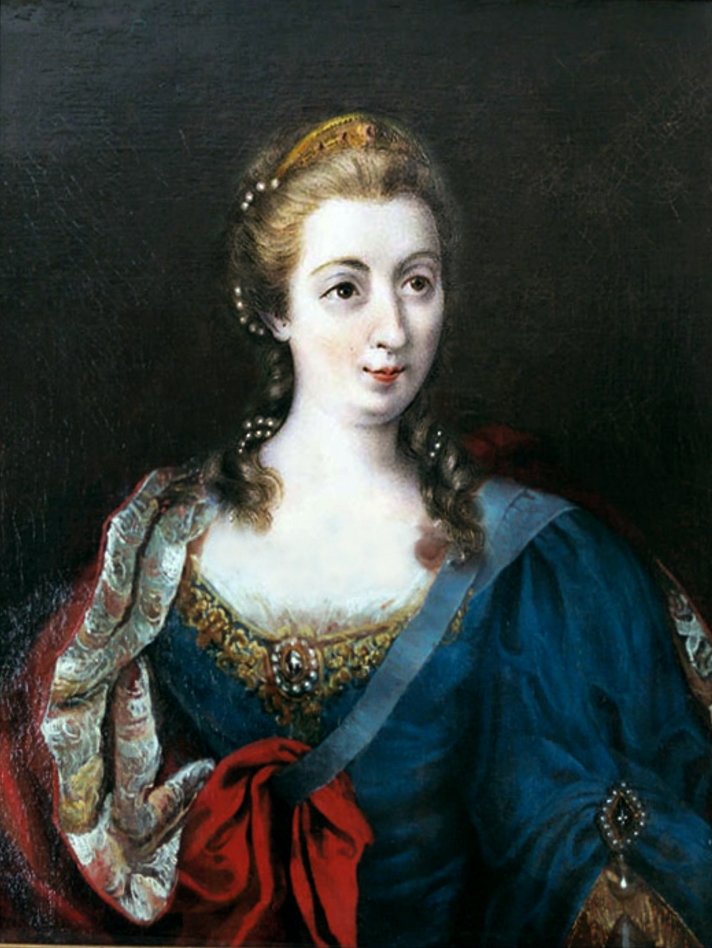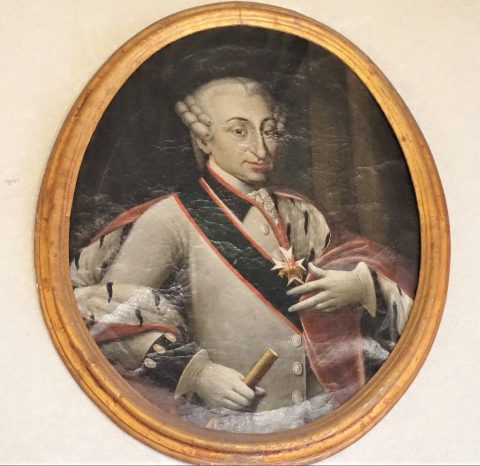Ercole III was the last legitimate heir to take the reins of the Duchy of Este and during his fourteen years of government, abruptly interrupted by the Napoleonic invasion, he paid great attention to the needs of the city and above all to those of the population, a behaviour that made him popular with everyone.
He tackled the problem of the lack of male heirs in a resolute manner, going so far as to arrange a very important marriage for his niece, still in her infancy, a union with the imperial house of Austria that would guarantee the future of the Este family through the Austro-Estense line of succession.
Due to the Napoleonic occupation, he was forced to leave Modena in May 1796, never returning to the Este lands.
The Life
Ercole Rinaldo was born in Modena on 22 November 1727, the son of Francesco III and Carlotta Aglae d’Orléans, he was the last legitimate heir to take over the leadership of the Estense Duchy. His father’s expansionist ambitions forced him to marry Maria Teresa Cybo Malaspina (1741), heiress of the Duchy of Massa and Carrara, thanks to which the Este family would obtain a valuable access to the Tyrrhenian Sea.

The union soon proved to be ill-matched. In 1750 the couple gave birth to a daughter, Maria Beatrice Ricciarda, whose birth complicated the age-old problem of succession. The firm desire of Duke Francesco III to immediately arrange a marriage for the newborn daughter that would guarantee the future of the Duchy clashed with the intentions of her father Ercole, who would have acted more cautiously for his daughter. Due to this opposition, the Duke went so far as to relegate Prince Ercole to the Ducal Palace in Sassuolo where, guarded by guards, he was forced to accept the unquestionable wishes of Francesco III: little Maria Beatrice Ricciarda was to be married to Archduke Ferdinand of Habsburg.
From 1768 Maria Teresa moved to Reggio, where she died in 1790 almost forgotten by her husband, who from the very beginning led a very licentious life entertaining himself in the company of countless women by whom he had several illegitimate children. When his wife died, he morganatically married his beloved Chiara Marini, with whom he had a natural son, the homonymous Ercole Rinaldo (1770-1795) Marquis of Scandiano.
In 1772 the prince led the Este troops to put down the revolt in Garfagnana, which had broken out due to the introduction of the coffee tax and in opposition to the corvées work imposed for the construction of the ducal road between Modena and Massa.
On the death of Francesco III (1780) Ercole Rinaldo became Duke and, although his government was short-lived, he continued the reforms initiated by his father and brought the State’s finances into credit.
Internal policy
Ercole Rinaldo III held the government of the Duchy for only fourteen years, interrupted by the French Revolution (1789-1799) and the Napoleonic invasion (1796), and in this short period he showed himself to be very careful of the needs of his citizens and shrewd in his spending, to the extent that he brought about the recovery of the treasury.

Every form of luxury and any unnecessary expenditure was banned from the court, going so far as to obtain from the Pontiff the reduction of public holidays in order to work more and consequently allow for less leisure and expenditure. The strict policy of reducing expenditure and the scrupulous administration of public money earned the Duke a reputation as a miser, a reputation that did not prevent him from establishing the Chamber of Accounts in 1787, which was to oversee all expenditure of public money.
In 1784 he had the civic hospital enlarged and the following year he founded the Accademia Atestina, an institute for artistic training, housed in the buildings of the old Inquisition tribunal, whose designer and first director was Giuseppe Soli.
The awareness that despite the presence of fortifications and the defence of the military forces, Modena could still be occupied, persuaded the Duke to decrease the allocation for the armed forces, dismantle the bastions, which became a transit area for citizens, and disarm the Cittadella, which was converted into a park.
The establishment of the city’s land registry dates back to 1786: from then on, all houses would have a tile placed on the façade that would ascertain their ownership, thus entailing a register of the population and, consequently, the discovery of any evaders.
In 1790, the Duke then abolished the grain trade duty, reduced the salt tax and also all taxes.
Following his vision of reducing useless defensive measures, between 1789 and 1793 he had two stone bridges built near Rubiera and Sant’Ambrogio, structures that Ercole Rinaldo’s predecessors had deliberately left in wood precisely for defensive purposes, because they could easily be demolished when invaders arrived and prevented their advance.
Continuing the reform of the law, promoted by his father through the institution of the ‘Estense Codex’, the Duke introduced new regulations to avoid interference in the administration of justice.
Ercole also took care of the Estense Library, greatly increasing its holdings and entrusting its direction to the scholar and historian Girolamo Tiraboschi from 1770. By the time of his death in 1794, the patrimony had reached very high numbers counting over ten thousand volumes, three thousand manuscripts and two thousand rare editions from the 15th and 16th centuries.
The Napoleonic invasion
In the last decade of the 18th century, the winds of protest from France could no longer be ignored, and the old policy of diplomacy and neutrality, which had always kept the Duchy safe, was now proving irrelevant in the face of the events of the French Revolution.
Napoleon’s invasion of Italy was imminent and the Duke once again tried the path of diplomacy and embassies, but the support given to the Emperor, already at war with France, quantified in cannons, ammunition, as well as the payment of the war tax and the loan of 750,000,000 zecchini, marked him out as an ally of Austria.
After Napoleon’s invasion of Milan in May 1796, the Duke realised that the occupation of the Duchy was also imminent, so he arranged a government regency and on the evening of 7 May left Modena by carriage for Venice. Behind him some boats transported precious objects and gold along the waterways of the Naviglio, which Ercole believed to be his property, as well as a sum taken from the public treasury, where he had left about 9 million lire from Modena. However, the lagoon city did not prove to be safe at all because the Duke was joined by a group of French soldiers who forced him to hand over 200,000 zecchini, just under seven quintals of gold.
In the meantime, in Modena, the Council of Government in agreement with the Duke concluded, through the full delegate Earl Federico Benedetto d’Este (1745-1820), an armistice with Napoleon (23 May 1796) that was very onerous for the Duchy, which was obliged to pay 7.5 million francs within two months to which were to be added provisions, ammunition and twenty paintings from the Ducal Gallery.
When the deadlines for paying the instalments were not respected, discontent began to spread among the population and the fear of having been abandoned by the Duke, a concern instigated by the republicans. Reggio was the first city to rise up and, on the night of 25 August, the population erected a poplar tree on the Piazza Maggiore as a symbolic tree of liberty from which hung this admonition: ‘Tremble, o perfidious ones, tremble, o tyrants, and look upon the sacred image of Liberty’. In the following days, in the wake of the events in Reggio, protests broke out in Modena too, characterised by violent clashes.
Due to the failure to respect the conditions imposed by the armistice, on 4 October Bonaparte occupied Modena and Reggio declaring that he was taking the citizens under the ‘protection of the French army’; two days later he dissolved the Este regency and proclaimed the republican government, presided over by a ‘Committee of Government’ and a ‘Municipality’ that remained in force until 1814.
On 15 October, Modena welcomed Napoleon with great festivities and at Palazzo Rangoni, from 16 to 18 October 1796, the Cispadano Congress was held, which was to constitute the Cispadana Confederation, later transformed into the Cispadana Republic, which would remain in force until 30 June 1797 when, at Bonaparte’s will, it would converge into the Cisalpina Republic based in Milan. The Italian flag was born in Reggio during the Second Congress held in December 1796 and would fly for the first time in February 1797, next to the French flag on the tree of liberty.
Among the new measures approved were the abolition of noble and gentilitial titles, the suppression of religious orders (1798), the closing of the University, the sale of Ducal Palace furniture, and the depredation of the Ducal Palace Library and Gallery.
Between May and September 1799, Modena changed government four times, between the Austrians and the French, a situation that increased the city’s despoliation and poverty. In the same year Napoleon assumed the title of first consul and in January 1802 the Cisalpine Republic became the Italian Republic, of which Bonaparte proclaimed himself president.
The following years brought stability. On 14 October 1803 the forgotten Ercole Rinaldo III died in Treviso who, unlike other dukes who returned to the capital of the Estensi after exile, never returned to his own state. After the Restoration in 1816 his body was transported to Modena and buried first in the Duomo and then, from 1898, in the ducal chapel of the Church of San Vincenzo.

After the death of Ercole Rinaldo III
On 18 May 1804 Napoleon became Emperor of France and consequently King of Italy and, after his coronation in Milan on 22 May, he passed through Modena where he was once again welcomed with great celebrations. But his star was already waning: after the disastrous Russian battle of December 1812 and the heavy defeat he suffered, he was in fact forced to abdicate on 11 April 1814.
The resulting Congress of Vienna in 1815 imposed on France the territorial borders it had had in 1789, and Italy too assumed the previous fragmentation into kingdoms and duchies, so that Modena, Reggio and Mirandola were handed back to Archduke Francesco IV, son of Ferdinand and Maria Beatrice Ricciarda. The people, disappointed by Napoleon’s policies and spoliations, were joyful to welcome the Este back, remembering that under the rule of Ercole Rinaldo years of peace and prosperity had passed. With this hope in his heart, on 15 July 1814 Francesco IV entered his Duchy to the great welcome of the population.
BIBLIOGRAPHY:
“Gli Estensi. A thousand years of history” Luciano Chiappini, Ferrara, Corbo Editori, 2001
“Gli Estensi. The court of Modena” edited by Mauro Bini, Il Bulino art editions
“Modena Capitale” Luigi Amorth, Banca Popolare dell’Emilia Romagna, Poligrafico Artioli SpA, 1997
Treccani Bibliographical Dictionary of Italians






